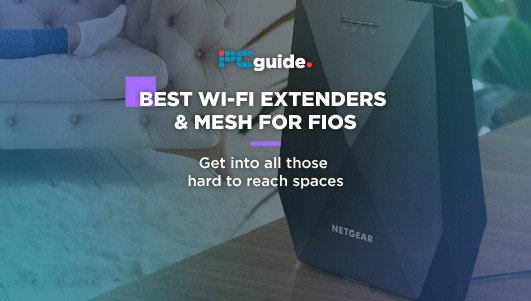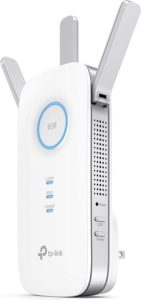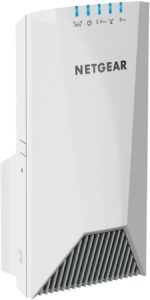Best WiFi Mesh and Extenders for FIOS in 2025

Table of Contents
WiFi is just something we expect these days. Wherever you are in the world, the age-old question of “What’s the WiFi password?” is bound to crop up and for the most part, it’s a 50/50 chance of either being the best or worst connection in the world.
The issue is that this shouldn’t be the case when you’re at home. Moving from the bedroom to the toilet shouldn’t disturb that last five minutes of Netflix before you flush, nor should just going into another room downstairs.
So this is where WiFi Extenders and Mesh Networks come in. While Extenders are fairly self-explanatory, there’s a little more to the Mesh Networks that are now seemingly superseding them in some cases.
In this article, we break down the best WiFi extenders for FIOS, helping those of you who are on Verizon’s network.
Products at a Glance
What is a WiFi Extender?
A WiFi Extender is quite literally a device that feeds off the back of your current connection and provides a ‘new connection’ to enable the signal to flow a little more through the house. While not as reliable as mesh, due to the fact that it can often degrade the quality of the network entirely once connected or that it might need to be reconnected to manually, it’s a great way to cheaply get your WiFi to blanket the house in areas it won’t hit.
What is Mesh?
Mesh WiFi is a newer technology that’s made it to the consumer in the last few years, which comes in ‘nodes’ that you can litter your house with for a seamless wireless connection wherever you are in the house. These nodes often come with backhaul capabilities to ensure you only get the best connection when using the mesh system.
The more nodes around the house, the more your connection is going to reach areas of the house it wouldn’t otherwise, but you’ll always want to consider not placing too many around the house in case of interference.
What is Backhaul?
Briefly, backhaul works by utilizing the node’s extra antennae either in or on the outside of the device. One takes in the data you want to be transferred between your device and the network, while the secondary backhaul network deals with the excess data not currently dealing with your device. This could be the communications between each node or other device traffic.
What we considered
For this Buyer’s Guide, we decided to not include any total replacements. Verizon FIOS is notoriously a headache-inducing nightmare to replace the whole cloth and these best WiFi extenders for FIOS recommendations are simple to get your connection from one end to the other with the only hassle being that you’ll have to go through their setup.
Product Reviews
- Works independent of the brand
- Atennae that can be swivled into position
- Add more nodes with the app
- 2000 sq.ft with each node
- Still not as good as a dedicated wired connection
- Takes up a whole socket
The technology behind Mesh WiFi extenders is just far and away better than your traditional WiFi extender. While there are limits to both, being able to position the nodes wherever you like within the house and also begin expanding your network to include more as you see fit, is just ideal in 2021. Of course, going full into a Mesh Router system would be ideal, but with Verizon making it difficult, it can be off-putting for a lot of us.
The Amplifi HD WiFi MeshPoint is a really cool device that is absolutely worth its price. It works independently of the brand, with the app having a dedicated setup mode for third-party routers, and the option to twist it to get the best signal is always a great boon too, plus it works with Verizon FIOS.
With a 2000 sq. ft range, it’s not the largest range, but, the option to add more and more to your network without much hassle outside of colliding signals is far better than a single device that gets bogged down.
- Adjustable antenna
- Gigabit Ethernet port
- Dual-Band Wi-Fi
- 2800 sq.ft.
- Takes up whole socket
- Mid-range price, Mid-range device
With a range of 2800 square feet and being able to handle 1900 megabits of data at a time, this extender is one of the best traditional extenders. The three antennas deal with backhaul for you, while the ease of setting it up is a huge selling point.
Not elaborately expensive, this WiFi Extender from TP-Link works with your Verizon FIOS, and adjusting the antennas is ideal for getting the connection to the right place.
It’s also great for older devices that don’t work with the 5Ghz band of Wi-Fi, allowing Dual Band, so your newer devices can take advantage of the 5Ghz signal, but older devices can be plopped onto the 2.4Ghz network for a seamless connection.
What’s really nice about this is that it can be set anywhere in the house and then provide a gigabit internet connection over the Ethernet port on the side, so wired devices or those that just need the flow of a wired connection to take part in the extension of your signal.
- Handles up to 45 devices
- 2300 sq.ft range
- Up to 2200Mbps bandwidth
- Mesh Roaming
- Takes up a whole socket
- Multiple devices on the network can cause headaches
- Limited to 250Mbps Speed
I highly recommend the Netgear EX7500, a mid-range – albeit ‘expensive’ mid-range – that can handle 45 devices at the same time. It also features Mesh Roaming, which will reconnect and disconnect you based on your location, to ensure a seamless transition between hot and cold zones for each device.
Of course, the really nice thing about this is that it is compatible with almost any router and system. If you intend to feature more than one in your house, just make sure it’s not connecting to the other extender, but the router and treat it as a separate device.
Netgear is incredibly reliable and even with the small issues with bandwidth being advertised as ‘speed’ – this can host up to 2200Mb/s of activity, not go that fast – it’s still an incredible choice to leap onto, if not for Netgear’s reliability alone.
- Cheap
- 2.4 and 5GHz networks
- Potentially unreliable
- Off-brand
You always get the off-brand, cheap models and in most cases, they’d be avoided like the plague for fear of the reaper coming to grab you from the flaming pit that was your house. However, the JYH WiFi Range Extender is a great cheap alternative for putting between your kids’ room or elsewhere around the house for that extra jump in connectivity where it might be needed.
It has a dual-band network, with 300Mbps for the 2.4Ghz, while around 900 for the 5GHz, providing you with plenty of speed and compatibility with two waves coming out of it.
Obviously, this shouldn’t be the only or your main device in the house for extension, there are better models at more expensive price points that I would use as your primary WiFi extension point.
Wired Options?
The thing is, wireless connections will only ever go so far. While WiFi 6 promises speed comparable to modern wired connections, there’s still the issue of distance and how the transmission physically works. So yes, at another point we’ll discuss network switches and power line adapters, but if your PC is in need of a wired connection, I’d highly recommend looking into these devices.
They work by transmitting the signal via Ethernet through your house’s electrical wiring, so you can have one hooked up anywhere and everywhere there’s a plug socket on the same circuit. This also eliminates the hassle of trying to find one that is compatible with your Verizon FIOS connection, which Americans, I find baffling that this is a thing you have to take into consideration.
Our Verdict
It’s lean, mean, and to the point. One, two, or more in the house and you’ll have Wi-Fi just about everywhere with no issues whatsoever. The AmpliFi MeshPoint is expensive, but it’s worth it for all the ease of use it brings with it. Adding things in the app is a breeze and the FIOS compatibility is just the last checkbox on the list that it ticks. Fast, easy to fit and if you ever decide to upgrade to the router, you’re bound to find this a benefit.





